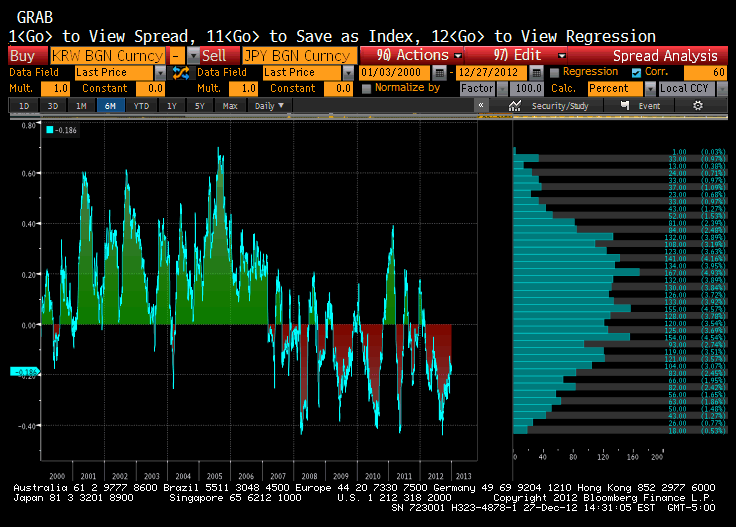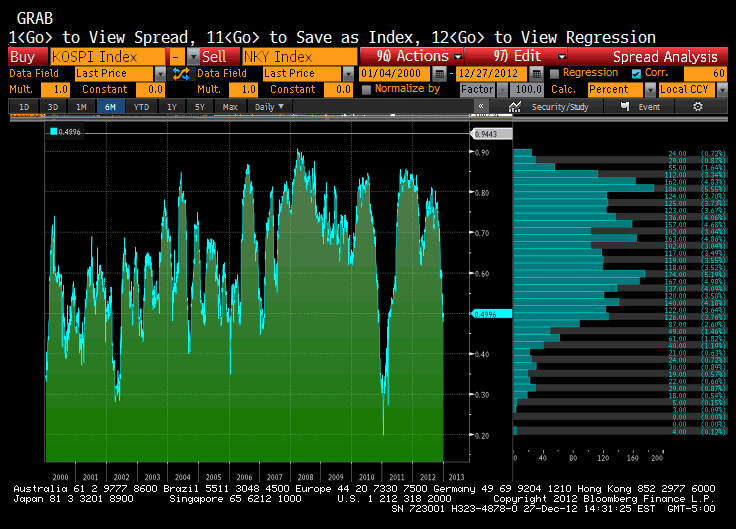These Great Graphics come from Bloomberg. I created them as part of an investigation into the impact of a weaker yen outside of Japan. Japan and Korea compete in various industries.
Determined To Weaken The Yen
As is well appreciated, the newly elected Japanese government is determined to weaken the yen as a means to fighting deflation and reviving the economy.
Thus far there has been very little push back against the purposeful attempt to depreciate the yen.
No Effect On Yields
Within Japan, the weaker yen has helped fuel strong gains in the Nikkei. This seems understandable, as the weaker yen will boost the competitiveness of Japanese companies. However, the prospects of currency depreciation have not sparked a commensurate increase in Japanese yields (to compensate for the currency risk).
The 10-year JGB (generic) yield reached a multi-year low on December 7 near 0.685% (according to Bloomberg). Today the yield briefly poked through 0.80%. What is important is not the percentage move, but the absolute yield relative to the anticipated currency depreciation.
So Far, No Coplaints From S. Korea
Outside of Japan, there has been no push back against Abe and his intentions. We suspect South Korea would be a likely candidate to object. It had previously taken macro-prudential measures to curb the speculation in the won. One would have anticipated the combination of yen depreciation (-4.5% over the past month, the weakest of the Asian currencies) and appreciation of the won (+1.1% over the past month, the strongest of the Asian currencies) would have elicited a response. So far, nothing.
The above graph shows the (60-day percentage change) correlation of the won and yen since 2000. The first part of the period, the correlation was positive (green), meaning that the size of the moves of the won and yen against the dollar were similar. However, since around the time the crisis began , the correlation is more often inverse. Of note, the inverse correlation has been reduced over the past month. It's inverse correlation bottoms in mid-September near -0.43. Now it is near -0.19.
The graph below shows the correlation (60-day percentage change) between Japanese shares (Nikkei) and Korean shares (Kospi). One can see that the correlation has consistently been positive, mostly between 0.40 and 0.85. The correlation has weakened considerably in recent months. After peaking near 0.80 in July-Sept, it is now just below 50. This is the lowest since March 2011.
Admittedly, there are other influences besides the direction of the yen. Korea, for example, also recently held elections and the new government, like all new governments, is full of possibilities. While Japan has shifted to the right, South Korea has appears to have shifted to the left.
Japan's Dollar Objective
In any event, we expect the depreciation of the yen to increasingly risk the ire of Japan's trading partners. However, in the greater scheme of things, the Abe government in Tokyo is not seeking massive depreciation of the yen. The JPY90 objective would still leave the dollar below the 2010 high set near JPY95. It would also leave the yen under-valued on the OECD's purchasing power parity. The OECD's model estimates the yen is over-valued by about 19.5% against the dollar.
Lastly, we suspect Abe is placing too much importance in the yen's bilateral nominal exchange rate. Ministry of Finance data suggest that Japanese companies, like their US counterparts, service foreign demand more by building locally and selling locally than via exports. This means that the weakness in the yen may not be as beneficial to the overall Japanese economy as it may have been in the 1980s and 1990s.
- English (UK)
- English (India)
- English (Canada)
- English (Australia)
- English (South Africa)
- English (Philippines)
- English (Nigeria)
- Deutsch
- Español (España)
- Español (México)
- Français
- Italiano
- Nederlands
- Português (Portugal)
- Polski
- Português (Brasil)
- Русский
- Türkçe
- العربية
- Ελληνικά
- Svenska
- Suomi
- עברית
- 日本語
- 한국어
- 简体中文
- 繁體中文
- Bahasa Indonesia
- Bahasa Melayu
- ไทย
- Tiếng Việt
- हिंदी
Japan's Yen And South Korea's Won
Published 12/27/2012, 03:51 PM
Updated 07/09/2023, 06:31 AM
Japan's Yen And South Korea's Won
Latest comments
Loading next article…
Install Our App
Risk Disclosure: Trading in financial instruments and/or cryptocurrencies involves high risks including the risk of losing some, or all, of your investment amount, and may not be suitable for all investors. Prices of cryptocurrencies are extremely volatile and may be affected by external factors such as financial, regulatory or political events. Trading on margin increases the financial risks.
Before deciding to trade in financial instrument or cryptocurrencies you should be fully informed of the risks and costs associated with trading the financial markets, carefully consider your investment objectives, level of experience, and risk appetite, and seek professional advice where needed.
Fusion Media would like to remind you that the data contained in this website is not necessarily real-time nor accurate. The data and prices on the website are not necessarily provided by any market or exchange, but may be provided by market makers, and so prices may not be accurate and may differ from the actual price at any given market, meaning prices are indicative and not appropriate for trading purposes. Fusion Media and any provider of the data contained in this website will not accept liability for any loss or damage as a result of your trading, or your reliance on the information contained within this website.
It is prohibited to use, store, reproduce, display, modify, transmit or distribute the data contained in this website without the explicit prior written permission of Fusion Media and/or the data provider. All intellectual property rights are reserved by the providers and/or the exchange providing the data contained in this website.
Fusion Media may be compensated by the advertisers that appear on the website, based on your interaction with the advertisements or advertisers.
Before deciding to trade in financial instrument or cryptocurrencies you should be fully informed of the risks and costs associated with trading the financial markets, carefully consider your investment objectives, level of experience, and risk appetite, and seek professional advice where needed.
Fusion Media would like to remind you that the data contained in this website is not necessarily real-time nor accurate. The data and prices on the website are not necessarily provided by any market or exchange, but may be provided by market makers, and so prices may not be accurate and may differ from the actual price at any given market, meaning prices are indicative and not appropriate for trading purposes. Fusion Media and any provider of the data contained in this website will not accept liability for any loss or damage as a result of your trading, or your reliance on the information contained within this website.
It is prohibited to use, store, reproduce, display, modify, transmit or distribute the data contained in this website without the explicit prior written permission of Fusion Media and/or the data provider. All intellectual property rights are reserved by the providers and/or the exchange providing the data contained in this website.
Fusion Media may be compensated by the advertisers that appear on the website, based on your interaction with the advertisements or advertisers.
© 2007-2024 - Fusion Media Limited. All Rights Reserved.
